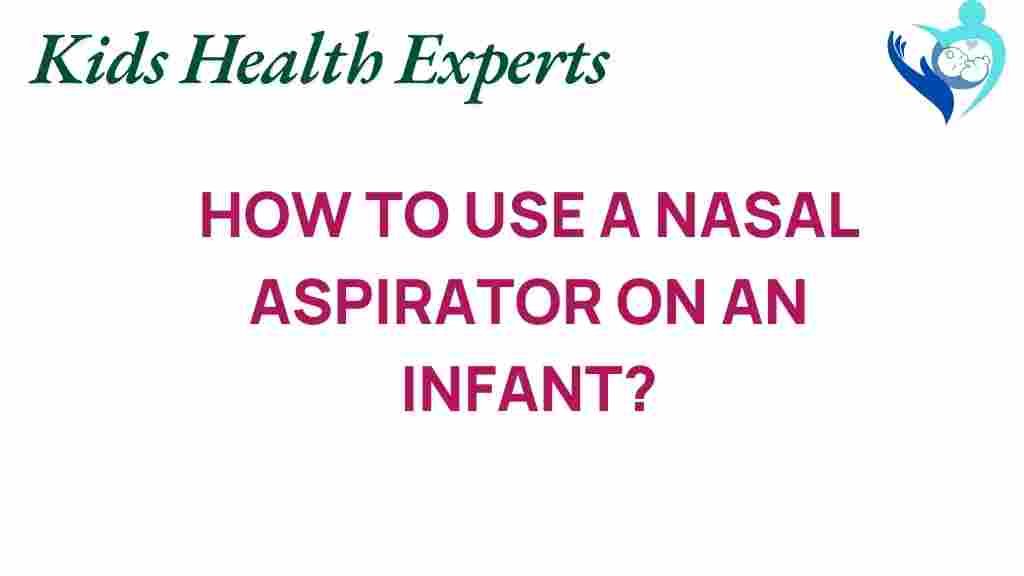Mastering the Nasal Aspirator: Essential Tips for Infant Care
As a parent, ensuring your baby’s wellness is a top priority, and maintaining their respiratory health is crucial, especially during cold and flu season. One effective tool in your parenting toolkit is the nasal aspirator. This device helps to clear mucus from your infant’s nasal passages, making it easier for them to breathe and eat. In this article, we will provide essential tips for using a nasal aspirator, guidance on hygiene, and how to effectively incorporate this tool into your infant care routine.
Understanding the Nasal Aspirator
A nasal aspirator is a device designed to remove mucus from a baby’s nose. Excess mucus can lead to discomfort and difficulty breathing, which can affect feeding and sleeping. There are several types of nasal aspirators available:
- Bulb Syringe: A classic tool that uses suction created by squeezing the bulb.
- Electric Aspirator: A battery-operated device that provides consistent suction.
- Oral Suction Aspirator: A device that allows parents to create suction by sucking through a mouthpiece.
Each type has its pros and cons, so understanding what works best for your baby is key to effective infant care.
Step-by-Step Guide to Using a Nasal Aspirator
Using a nasal aspirator can be straightforward, but proper technique is essential. Follow these steps for effective use:
- Choose the Right Time: Pick a moment when your baby is calm, preferably after a bath or when they are sleepy.
- Gather Your Supplies: You’ll need the nasal aspirator, saline drops (if desired), and a clean tissue.
- Prepare the Aspirator: If you’re using a bulb syringe, squeeze the bulb to expel air before placing it in your baby’s nostril. For electric aspirators, ensure it’s charged and ready to go.
- Administer Saline Drops: If your baby is congested, place a few saline drops in each nostril to help loosen mucus.
- Position Your Baby: Gently hold your baby in your lap or lay them down on their back, ensuring their head is slightly tilted back.
- Insert the Aspirator: Place the tip of the nasal aspirator gently into one nostril, being careful not to insert it too far.
- Suction: If using a bulb syringe, release the bulb slowly to create suction. For electric aspirators, simply turn it on. You will see mucus being drawn into the device.
- Remove and Clean: After suctioning, remove the aspirator and wipe the tip with a clean tissue. If using a bulb syringe, squeeze it to eject the mucus into a tissue.
- Repeat as Needed: Switch to the other nostril and repeat the process, but limit the suctioning to avoid irritation.
Health Tips for Using a Nasal Aspirator
Here are some health tips to keep in mind while using a nasal aspirator:
- Frequency: Use the aspirator as needed, but avoid excessive suctioning to prevent nasal irritation.
- Hygiene: Always clean the aspirator after each use to prevent the spread of germs. Follow the manufacturer’s instructions for cleaning.
- Know the Signs: If congestion persists or is accompanied by fever, consult your pediatrician for further guidance.
- Comfort Your Baby: Always comfort your baby before and after using the aspirator, ensuring they feel secure and loved.
Troubleshooting Common Issues
Even with the best intentions, you may encounter some common issues when using a nasal aspirator. Here are troubleshooting tips:
- Blocked Aspirator: If the aspirator is not suctioning well, check for any obstructions in the tip. Clean it thoroughly.
- Baby is Uncooperative: If your baby resists, try swaddling them or using a pacifier to soothe them before attempting again.
- Too Much Mucus: If your baby has a lot of mucus, it may take a few tries to clear their nose. Just be patient and gentle.
- Discomfort: If your baby shows signs of discomfort, stop immediately and comfort them. It may be too much for them at that moment.
Ensuring Hygiene and Safety
Maintaining hygiene is crucial in infant care, especially when dealing with respiratory issues. Here are some hygiene tips:
- Wash Your Hands: Always wash your hands before and after using a nasal aspirator.
- Disinfect Regularly: Use mild soap and water to clean the aspirator. For thorough disinfection, consider boiling it or using a sterilizer.
- Avoid Sharing: Do not share nasal aspirators between children to prevent cross-contamination.
- Store Properly: Keep the nasal aspirator in a clean, dry place when not in use.
Pediatric Guidance on Infant Nasal Care
When it comes to your baby’s health, always seek pediatric guidance if you’re unsure about using a nasal aspirator or if your baby is experiencing persistent congestion. Your pediatrician can offer tailored advice and possibly recommend other treatments if necessary. For more information on respiratory health and infant care, consider visiting trusted sources like the American Academy of Pediatrics.
Conclusion
Mastering the use of a nasal aspirator can significantly enhance your infant care routine, contributing to your baby’s overall health and comfort. By following the tips and techniques outlined in this article, you can ensure that you are using the nasal aspirator safely and effectively. Remember, parenting is a learning journey, and utilizing the right tools is essential for your baby’s wellness. For more parenting advice and health tips, stay informed and consult with healthcare professionals as needed.
For further reading on infant respiratory health, check out this resource.
This article is in the category Care and created by KidsHealthExperts Team
